Did The Hot Iron Get a Nokia OpenLab Bump?
Did traffic increase to The Hot Iron following my participation in the Nokia OpenLab in Helsinki last month? In general I would hope so, as after meeting many interesting people I started following them online, and I would hope someone would be interested in what I have to say! But the numbers do not lie, and here’s a summary of activity on this little blog.
In this analysis, I used 2 sources. I use Who’s Lookin?, a service by Fiodan Corp., for tracking and reporting daily activity. Every morning I receive an email report of top pages accessed, top referring sites, as well as what networks have visited. This is an excellent indicator of traffic volume and where it is coming from. Watching this report on a daily basis, I saw increased international traffic, and traffic coming from Nokia itself, mostly after OpenLab. These reports gave me a good “gut” feel that I did receive some sort of bump in traffic. For the sake of full disclosure, Dunkirk Systems, LLC a value-added reseller of Who’s Lookin? and am more than glad to talk to you about how this service can help your business!Google Analytics is the other source of data for this analysis. I did a comparison of 2 date ranges – the month of August, 2008 vs. September 2008. As I did my original post on OpenLab on September 1, this would give a good indication of what traffic was like beforehand and after the fact. Below is the chart of Analytics comparing visitors over those periods.
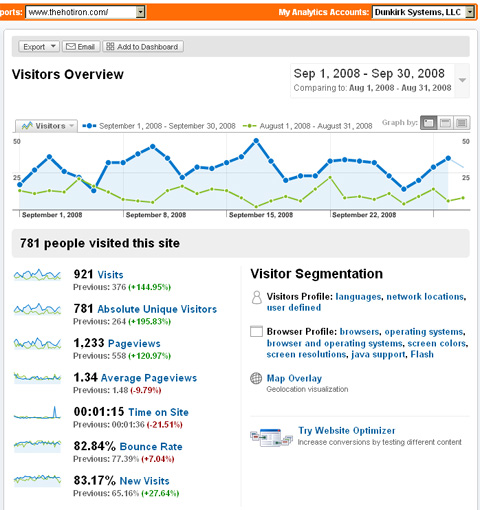
As you can see, there is a definite increase in visits to The Hot Iron, but it did not lead to people spending more time once they arrived. The next analysis I did was on new vs. returning visitors, and here is the Analytics comparison during the same periods.
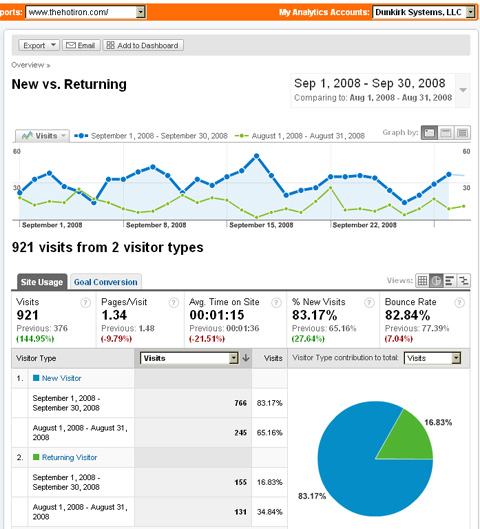
As you can see, there are many new people, and for those who are new, welcome!
Two other areas I looked at showed no increases – searches and Feedburner subscriptions. OpenLab did not figure into the top search terms that drove traffic to The Hot Iron. Also, there was not a significant change in Feedburner subscriptions. Feedburner does not allow you to analyze traffic beyond 30 days, plus I have always found strange fluctuations in subscriptions on a daily basis that I haven’t considered that a serious traffic stat. I look forward to its further integration into Google, and perhaps into Analytics as well.
In summation, I did receive some bump during the period after OpenLab. If you are one of those who started reading after OpenLab – or not – please feel free to comment as to what brought you here.
Did you enjoy reading this? You are welcome to subscribe to The Hot Iron by RSS feed or by email.
Ridiculous Register Receipts
To end the week on a lighter note, I thought I’d share a couple of register receipts I recently received. In general, I think these receipts are getting a bit ridiculous in their length and never-ending offers for surveys. However these 2 were truly unique.
The first one is one of those “checkout coupons” you get along with your receipts, and this came from Walgreens.
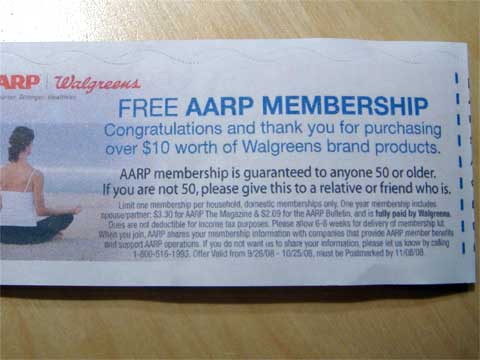
This receipt reads, “Free AARP Membership, Congratulations and thank you for purchasing over $10 worth of Walgreens brand products.”
First off, I don’t think I need to be congratulated on purchasing Walgreens private label products. As they don't offer as many as CVS does, maybe seeking them out is something unusual? I wouldn’t think of photo reprints as a branded product, but maybe I am splitting hairs. But I am not splitting anything over the offer – free AARP membership! As they don’t specifically know how old I am – they have no loyalty card and I paid cash – what’s up with this? I like how they suggest if I am not 50 to give it to someone else – good try, but not good enough. Ok, so I only have 9 years to go, but I am in no hurry to join that club.
This one is a gem. With the exception of Trader Joe’s, most grocery store checkout clerks are grumpy. Despite this, their name usually appears on the register receipt. Am I going to ask for them upon my next visit, or say ‘have a nice day’ and use their name when they never give me eye contact? Well, I will do the latter just to tick them off. But someone either decided to be funny at Jewel-Osco or confused their name for their nationality.
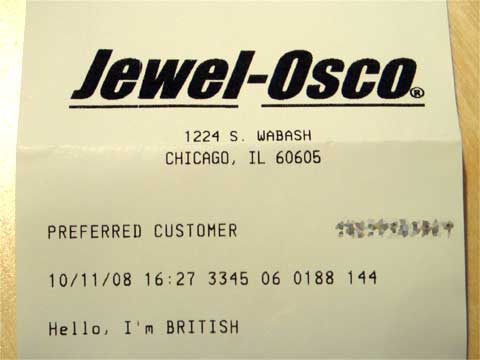
This receipt reads, “Hello, I’m British”
To the Queen! Have a great weekend.
Did you enjoy reading this? You are welcome to subscribe to The Hot Iron by RSS feed or by email.
Nokia E71 Is A Business Colleague
Prior to attending Nokia OpenLab, I was sent a Nokia E71 device for evaluation. Unfortunately I did not get time to do more than charge it before my trip, though I did get a walkthrough from the friendly staff at the Nokia Flagship Store in Chicago. Upon my arrival in Helsinki, I inserted the Finnish SIM card I got from Nokia and started using the E71 as my primary phone, as well as camera, notebook, etc. When I got back to the states I went back to my Treo 680, but then decided I really needed to put the E71 to task and put my own SIM in it, and used it as my primary phone for the next several weeks. Here’s my recap of this extremely positive experience.
Symbian For The Palm Guy
This was my first hands-on experience working with the Symbian operating system (OS) and S60, the platform that runs on it that powers the device. I had heard great things about it, namely its level of customization. This was a completely new thing for me, as a user of the Palm OS since the mid 90’s. Sadly, other than going color, Palm OS hasn’t evolved much over the years. There has been more activity on the ownership side of Palm OS, and the technical name for it today is now Garnet OS.
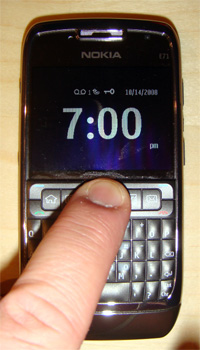 One of the first changes I made to the configuration was to show options and applications in list form rather than icons and to change the skin, both to make it easier for me to read. The general flow of S60 was logical, though there were some options that were not exactly where I thought they would be. I did like the home screen, with a clock and customizable list of icons for the options I would use most. A cool feature, in addition to the glowing Navi Scroll Key, is when you press the key when it is glowing, the time is displayed, which is handy as I (as well as others I am sure) use their device as a watch.
One of the first changes I made to the configuration was to show options and applications in list form rather than icons and to change the skin, both to make it easier for me to read. The general flow of S60 was logical, though there were some options that were not exactly where I thought they would be. I did like the home screen, with a clock and customizable list of icons for the options I would use most. A cool feature, in addition to the glowing Navi Scroll Key, is when you press the key when it is glowing, the time is displayed, which is handy as I (as well as others I am sure) use their device as a watch.
Using S60 is to learn S60 and to appreciate it. I most appreciated it being multi-threaded, so I could go between the browser, the phone and back without having to renavigate to where I was. I was also able to do everything using keys, as the E71 does not have a touchscreen. Though I (and others who are iPhone users) were tapping away at it at first, I quickly got over it when I was able to get to where I wanted to be. By walking through all menu options, I was able to truly learn all I could do.
The Physical E71
Of course I did a lot of comparisons between the E71 and my Treo 680. Palm once owned this market, and it was stripped from them by the likes of BlackBerry and now Nokia with this model. The phones had similar width and height, but the E71 is about half the thickness. This may be due to it not having a touchscreen, or just better design. Despite the size difference, it is only slightly lighter than the Treo, but it feels like a solid device, and a lot of that may be due to the amount of metal in the case. The keyboard took a little adjustment – the keys touch each other where on the Treo they do not. Also, the number 0 was to the right of the 9 rather than below the 8 and the * and # keys were to the side of 3 and 6 respectfully. On many occasions I hit the wrong keys when checking voicemail. Once I got over this, I forgot about it with the @ key being a primary key among other changes from the standard QWERTY keyboard.
There are 2 cameras on the E71, one on the front and one on the back. The one on the front is presumably so you can take pictures of video of yourself while you watch yourself. The camera itself was hit or miss with me, and I was prompted to test this from others’ experience. Pictures in brighter light came out better than those in dimmer light. Note my degree is in computers and not photography, and it could have also been what I was shooting and how. I was not a fan of the “spotlight” flash on the camera (there is only one flash, on the back) as when taking pictures of my baby daughter or other infants in dim light, it was impossible to get a shot without them wincing. But it is a 3.2 megapixel camera, and there were decent pictures I got from it, and it beat the socks off of the 640 x 480 pictures I get from the Treo.
Other thoughts on the E71 include the very long-life of the battery, the decent amount of memory (namely as I did not add a memory card to it) and the magnet that it is to fingerprints. I would put a piece of screen-guard film over the screen to reduce some of this. It only crashed on me once, interestingly when I was locking the keyboard. Crashing once in a month is not bad as compared to the several times a week it happens to my Treo 680.
Down To Business
The E71 is part of Nokia’s business line, and the phone does not disappoint. As I simply used the device without a plan, I hit on many of the features that were selling points to me on it. I was able to easily setup 2 POP email accounts, and could check mail with no problem. It took a little poking around to get email lists to show on 2 lines, and how I could choose to download entire messages or not. At one point I filled the on-board memory of the device and in my attempt to try to check mail, I somehow blew away my mailboxes. Not sure what I did, I recreated them and was back in business.
Browsing the Web was enjoyable as I was able to view full Web pages. I like how the browser will load a page, show part of it and as you scroll show you where you were on the larger page. Bookmarks showed favicons, a nice feature, and I was able to use pretty much any Web site I tried on it. And the multi-threaded S60 is worth mentioning again, as I was able to go between calls and the Web without losing my place.
You can create, edit and view Office documents on the E71. All I did was view a couple of Word documents that were emailed to me and I didn’t even realize I could do it – this is something I do on the Treo 680 all the time, and just assumed I could perform it on the E71 as well, and was not let down. I like the idea you can work with PowerPoint, as it would be a great tool to use for reviewing a presentation.
Applications I had fun with were Qik and the barcode reader. I had heard of Qik but never used it myself. Shooting and streaming video over S60 devices is, borrowing from my Boston roots, wicked cool. As I have not been able to find a barcode reader for Palm OS, the one installed on the E71 allowed me to experiment with QR codes, the 2-dimensional barcodes that are now starting to appear more in the US, and will soon be appearing on my own business card. I should note I did not use the GPS features much on the device. I did use Sports Tracker application one day on a walk to a business meeting, but I did not fully exploit these features.
I never installed the Nokia PC Suite and as a result never loaded my contacts onto the phone. This will be something to pursue once I get my own device as I am a Palm Desktop user and am not an Outlook user. The migration of contacts will probably take some work, a task I would like to avoid more than a trip to the dentist! I will probably check out Howard Forums and All About Symbian for input and advice as to the shortest path to completion of this task.
However I almost installed the PC Suite as I wanted to pull the pictures I took on the phone onto my PC. I was talking with tnkgrl at Nokia OpenLab and commenting I was about to do this, when she told me all I needed to do was plug in the USB cable, and the device would ask me how to “act” and I just had to choose it to act like a mass storage device, and it was like copying files from one drive to another. Sweet!
I Like It
In summary, I really like the Nokia E71. It is a durable, quality device that works with me to get the job done. It has a lot of the features the Treo 680 is lacking, and where there is a match of services, they are much better on the E71. It also sold me on Symbian and S60.
If you are looking for a new mobile device, I highly recommend you explore the E71. If you do, please feel free to comment as to your opinion of the device.
Did you enjoy reading this? You are welcome to subscribe to The Hot Iron by RSS feed or by email.
My Take-Aways From The Book Buying In
You have heard the saying ‘you are what you eat.’ But how about you are what you buy? Or the reverse? The latter question is the premise behind a great book Buying In: The Secret Dialogue Between What We Buy and Who We Are by Rob Walker.
In Buying In, Walker explores this relationship, or as he calls it dialogue, between what we buy and who we are. It is packed with examples of brands and consumer goods and the ways they interact with consumers, the very people who are on the selling side with the marketers and others who connect them with consumers. There are also many great terms that come from this book – from Pretty Good Problem describing a plethora of “pretty good” products to choose from, to Desire Code, which comprises all of the factors leading one to buy something to Murketing, a contraction of the words “murky” and “marketing” which are themes throughout the book.
My greatest takeaway from Buying In is the consumer can make – and sometimes demand – an individual connection with a product. Going away are the days of mass-produced and mass-marketed goods. The Internet has broken down the technical barriers between consumers and companies, and now companies need to realize this and converse with their customers. Technology alone won’t do it all, as there needs to be a fundamental realization first that a company wants to do this!
Another takeaway is consumers don’t want to feel like they have been sold something. Call it a win-win situation - or call it consumers don’t want to feel like they are at the bottom of a pipe of products being fed to them. Scion is cited as an example of this, where they took a non-traditional approach to reaching out to the Generation Y-ers, their target audience.
A final takeaway is that it may not be your product or service, rather how it is marketed. American Apparel moved form promoting their Los Angeles-based manufacturing and selling to wholesalers to retail stores selling hip clothing. Timberland created a professional shoe line to reconnect with their traditional market after growing a new base of younger, urban consumers.
Shortly after reading Buying In, I attended the Nokia OpenLab in Helsinki and saw in action a lot of what I read in Buying In. There were those who were Nokia mavens as well as those who have built businesses around Nokia products. Even Nokia has gotten into this by buying all of the Symbian operating system that powers their phones and turning it over to a non-profit foundation, open-sourcing it for all to develop on and extend. Where some may see this as a lack of control, Nokia doesn’t, and has profited well from this.
There are many other studies and examples in Buying In that get you thinking a lot about what you buy and why or what you sell and how. I highly recommend it to entrepreneurs and business people – large and small – as well as to those interested in why they may have the things they have.
This is from The Hot Iron, a journal on business and technology by Mike Maddaloni.
Did you enjoy this? Subscribe to The Hot Iron by RSS/XML feed or Read by Email.
Book Take-Aways • Business • (0) Comments • Permalink
Rebranding the Chicago Marathon
Yesterday was the 31st annual running of the Chicago Marathon. Formerly known as the LaSalle Bank Chicago Marathon, it is now the Bank of America Chicago Marathon as the latter bank bought the former. Drawing over 45,000 runners, it is a major event winding through the Windy City.
With the name change came a brand change. This was not surprising, as Bank of America owns the marathon. This is the former branding for the marathon:
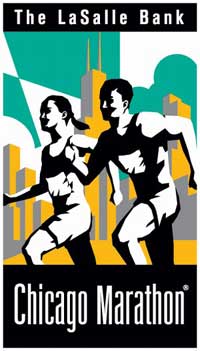
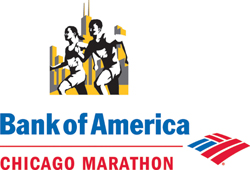
However come race day, the remnants of the old artwork were no where to be found on TV or along the course, and just the following was used:

For the sake of full disclosure, I am a Bank of America shareholder, though I never purchased the stock. I originally purchased stock in BayBanks, which was acquired by Bank of Boston, which was acquired by Fleet, which was acquired by Bank of America. Where their tag line is “bank of opportunity” to me it should almost be “bank of mediocrity?”
Did you enjoy reading this? You are welcome to subscribe to The Hot Iron by RSS feed or by email.




 Buy Me a Coffee
Buy Me a Coffee